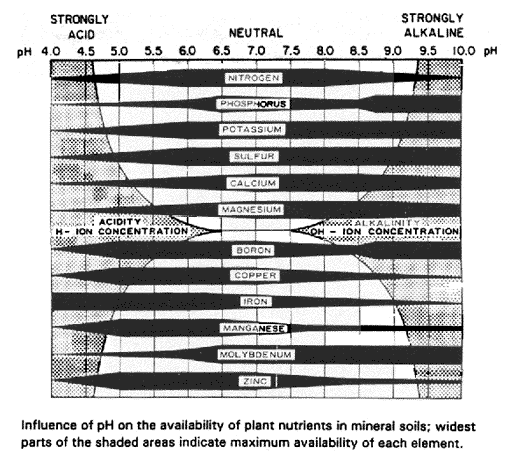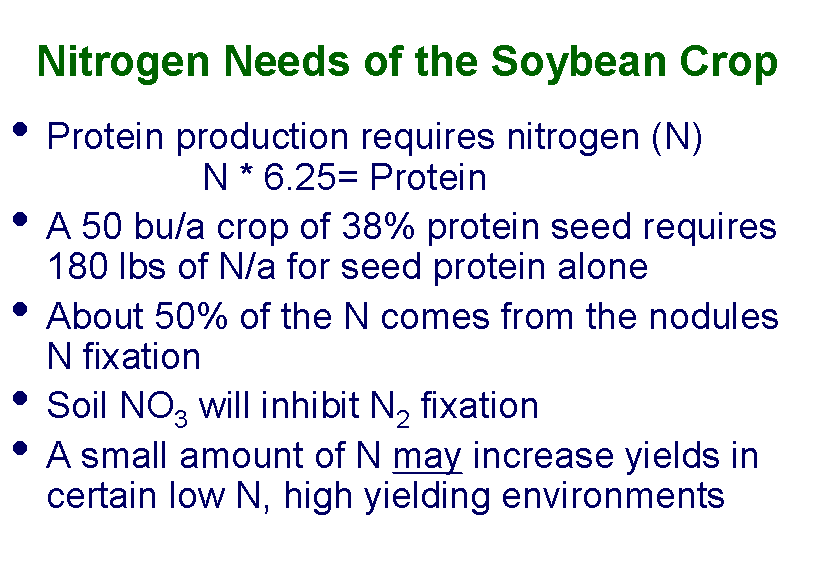Soil Fertility
Last updated on
February 23, 2014

Don't apply nitrogen to soybeans. Well nodualted soybeans will fix all the nitrogen
they require. It is better to inoculate the seed with Rhizobium bacteria
than to apply nitrogen fertilizer.
Nutrient Requirements and Uptake by Plants
Soybean plants (as well as the symbiotic bacteria associated with them) require
all of the following nutrient elements:
- nitrogen (N),
- phosphorus (P),
- potassium (K),
- sulfur (S),
- calcium (Ca),
- magnesium (Mg),
- iron (Fe),
- boron (B),
- manganese (Mn),
- zinc (Zn),
- copper (Cu), and
- molybdenum (Mo).
Most nutrients are absorbed from the soil; however part of the N is obtained from
bacterial fixation in the nodules and some S is absorbed (primarily as SO2 and H2S)
from the air. Soil nutrients are absorbed into the plant roots with water and move
up into the plant to the leaves and other vegetative plant parts.
The amounts of nutrients available vary with
- soil type,
- soil test,
- depth of soil, and
- tillage practices.
They are influenced by soil temperature and moisture conditions.
Roots will not grow into dry soil and moisture must be present for roots to absorb
nutrients from the soil. However excess moisture in the soil limits aeration, and
roots also require air (oxygen).
The amounts of nutrients taken up by the plants early in the season are relatively
small because the plants are small. However the nutrient concentration in individual
leaves of well nourished plants are as high during this period as individual leaves
later in the season. Uptake and accumulation of some nutrients in the leaves continues
throughout the season until maturity; uptake of others is completed by stage.
Redistribution of mineral nutrients from older plant parts to newer growing parts
is a primary source for some nutrients. Some nutrient elements are very
mobile in the plants and are readily translocated from older to newer plant parts.
Redistribution of N, P, and S is a primary source of these nutrients for
growth of the beans and results in severe depletion of these elements in the leaves,
petioles, stems, and pods during the late seed-filling period. However, some nutrients
such as calcium are very immobile in the plants and there is little redistribution
of these elements from older to new plant parts. Late season redistribution of mobile
materials that have accumulated in leaves and other plant parts without redistribution
of Ca results in increased Ca concentration in the leaves late in the season.
Redistribution of other elements in the plant generally is intermediate between
the extremes for very mobile N and immobile Ca. P and S are very similar to N. K
is redistributed from the vegetative plant parts to the developing seeds, but is
not redistributed from the pods. Zn and Cu are redistributed but not to the same
degree as N. Mn, Mg, Fe, B, and Mo are relatively immobile but not as immobile as
Ca. Very marked differences in mobility of Fe have been observed among different
soybean varieties.
Fertilizer Use and Fertility Management
When the soil cannot supply the plant nutrient requirements, fertilizers and/or
manure can be added to supplement the nutrient supply. Uptake of nutrients added
to soils is not always an efficient process. Under good conditions, the recovery
in the year of application ranges from 5 to 20 percent for phosphorus and 30 to
60 percent for potassium. However, additional nutrients are recovered in future
years.
Nutrients Most Commonly Deficient:
- Nitrogen is fixed and made available to the plants by the bacteria in the
nodules on the roots. Where soybeans have not been grown previously, inoculation
is needed to supply the desired bacteria. Liming of acidic soils is usually beneficial.
By making conditions favorable for N-fixation, the need for N fertilization is reduced
or eliminated.
- The availability of phosphorus and potassium in many soils is not adequate
for optimum yields so fertilizers and/or manure to supply these nutrients should
be applied where needed. Depending on soil pH, lime also may be needed.
- Applications of some of the other nutrients are desirable on some soils where deficiencies
exist. S, Fe, B, Mn, or Zn are the elements that are occasionally deficient.
Foliar fertilization micronutrients: Mo, Fe, Cu, B, Zn, Cl, Mn
Foliar fertilization may be effective, particularly if the soil is low in availability
of one or more micronutrients
Effectiveness usually depends on soil pH. Soil pH has a major effect on availability
of micronutrients reduced examples: available availability iron (fe) below ph 6.5
above 7.0 other micronutrients molybdenum (mo) above 7.0 below 6.0.

Iron chlorosis (deficiency)
- widespread in prairie soils of midwest (Iowa, Illinois, Minnesota)
- frequent in high lime (calcareous) soils, particularly in cool, wet weather and
poorly drained soils
- infected plants are light green to yellow in color
- plants may recover later in the season, but yields will be reduced
- best control is resistant varieties
- foliar application of sequestrene (iron chelate) is usually helpful
Molybdenum
- the micronutrient that is required in the smallest amounts for plant growth
- more likely to get a response if ph is < 6 because mo is tied up (unavailable)
in acid soils. It differs from the other essential micronutrients in this respect.
- Symptoms are light green leaves
- usually applied foliarly when a deficiency occurs
- molybdenum is difficult to apply with granular fertilizer because it is required
in such small amounts that uniform distribution is difficult.

|